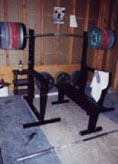IronMind Home Sweat Home
Building a Lifting Platform
By Randall J. Strossen, Ph.D.

It's no lie that the guts of a gym, for us, is a barbell, a set of squat racks, and a lifting platform. And while most people who lift weights are no strangers to the first two, unless you snatch and clean and jerk, you probably don't have a clear idea about how to build a good lifting platform. For starters, understand that the lifting platform is supposed to provide a solid, secure area for lifting - it is supposed to be capable of taking the pounding of heavy weights being dropped from arms' length overhead, day after day, and it needs to provide a sure-footed area for doing your lifts. It also provides some shock absorption, boosting the life of your expensive bumper plates, and it defines a zone that should be the exclusive territory of the person lifting at that moment. That's a tall order, and a properly built lifting platform requires the investment of some time and money, but it will last for years and will not only preserve your equipment and help your lifting, but it will increase your safety and comfort and that of those around you.
If you ever approach a weightlifting (as in Olympic-style weightlifting) gym, the first thing you will hear and feel is weights crashing down. Why? Heavy snatches and cleans and jerks are not lowered, but instead, are basically allowed to drop once the lift is completed, although to satisfy the rules, the lifter’s hands remain in contact with the bar until it at least passes waist height. Try lowering a heavy jerk, and you'll immediately see why these overhead lifts are basically dropped once completed. Something capable of taking this punishment has to be built right, and here's a proven design that anyone can execute.
Start with four sheets of 3/4-inch CDX plywood. Plywood is graded, following the pattern you learned in school, and CD is good enough for our purposes; X just means that it's exterior. Put two sheets side by side on the ground; then put the other two side by side (crosswise) on top of the first layer, so that the long side runs front to back on the first layer and side to side on the second layer. Use wood glue and screws to fasten these two layers together. At this point, you have an eight foot by eight foot square, 1-1/2 inches thick. Properly assembled, it is tied together as one unit, and it forms the basic understructure of your platform. Note that there are no hollow spots in this structure: there is a famous line about how if you have a hollow spot in your platform, a barbell will automatically find it and punch a hole through it.
Floor plans for your IronMind Tools for
Transformation
Here's an overview of how our Big Three pieces
of equipment might look on an 8' x 8' lifting
platform:
- A. Vulcan Racks - 24" front to back, 52" long
crosspiece - B. Five Star Flat Bench - 15" x 48"
- C. Pillars of Power - 31" front to back, 52" long
crosspiece

Floor Plan A:
Squatting with
Pillars of Power
as spotting system.

Floor Plan B:
Benching with
Pillars of Power
as spotting system.
To absorb shock, which will extend the life of your bumper plates, and to deaden some of the noise, put rubber where the plates will hit your platform. Since you also need a level surface across your entire platform, you need to build up the middle section, to match the height of the rubber on the outside edges. Here's the easiest way to do this.
You have an eight-foot square platform, so if you get two pieces of rubber two feet by eight feet, and glue each one, front to back, along the outside edges of your platform, that leaves you with a four foot by eight foot section in the middle—conveniently, you can drop another sheet of plywood into this valley, to make the entire platform level and free from gaps. Try to get rubber at least 1/2-inch thick, and get a piece of AB grade plywood for the center, matching its thickness to the thickness of the rubber. You splurge on the better grade of plywood for this top, middle section since you want a nice, uniform lifting surface.
Line up all the pieces, and then use wood glue, plus screws along the outside edges of the four foot side only, to fasten the center piece of plywood to the understructure, with the A side of the plywood facing up. Use high-strength contact cement to attach the two pieces of rubber to the understructure. You want this entire surface to be level and free from gaps or anything that might snag your heel (which is why you don't use screws along the front-to-back, eight-foot edge of the center piece of plywood). Because you need good traction, it should go without saying that you don't want to put anything slippery, like urethane, on the plywood.
This is a proven design, first explained to me by Jim Schmitz, and I can vouch for how well these platforms hold up. Expense aside, the toughest part might be finding the rubber, but look around for used conveyer belt, or something from an agricultural or ranching application, and you should be able to locate something suitable and save money at the same time.
Lift hard and heavy - with a good platform underfoot, there's nothing to stop you.
Reprinted with permission from MILO: A Journal for Serious Strength Athletes, June 2003, Vol. 10, No. 1.
Previous model Pillars of Power and Vulcan Racks System pictured.





